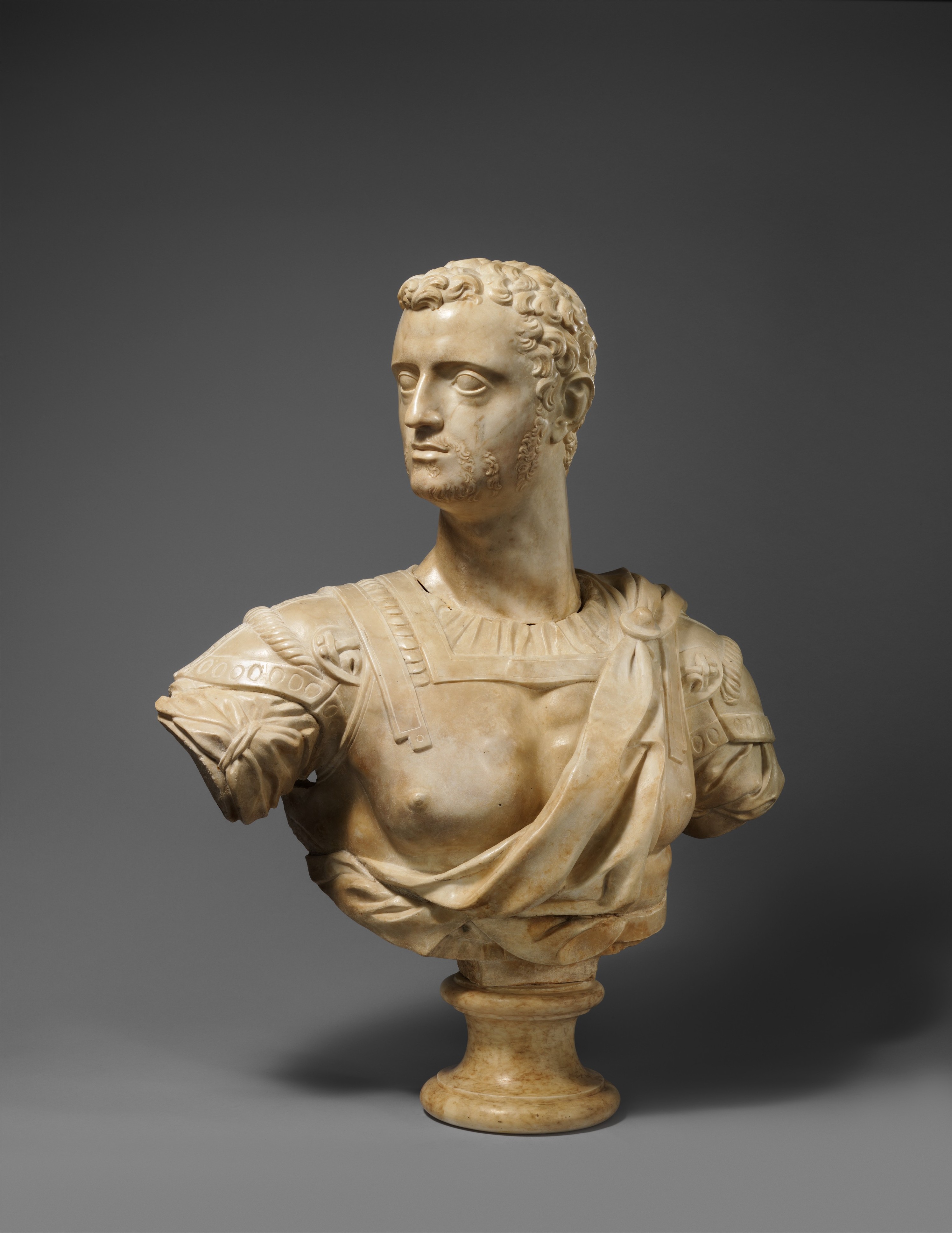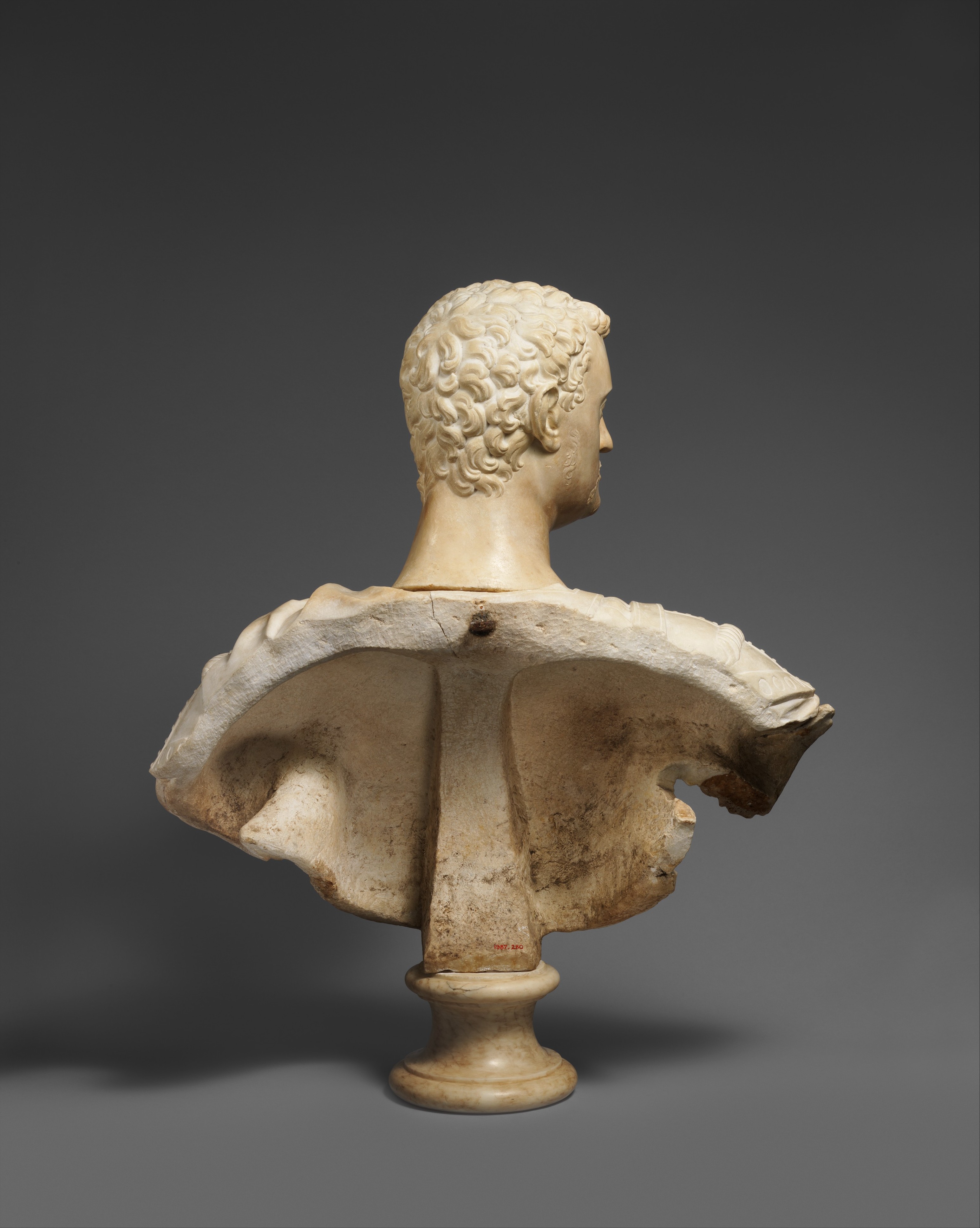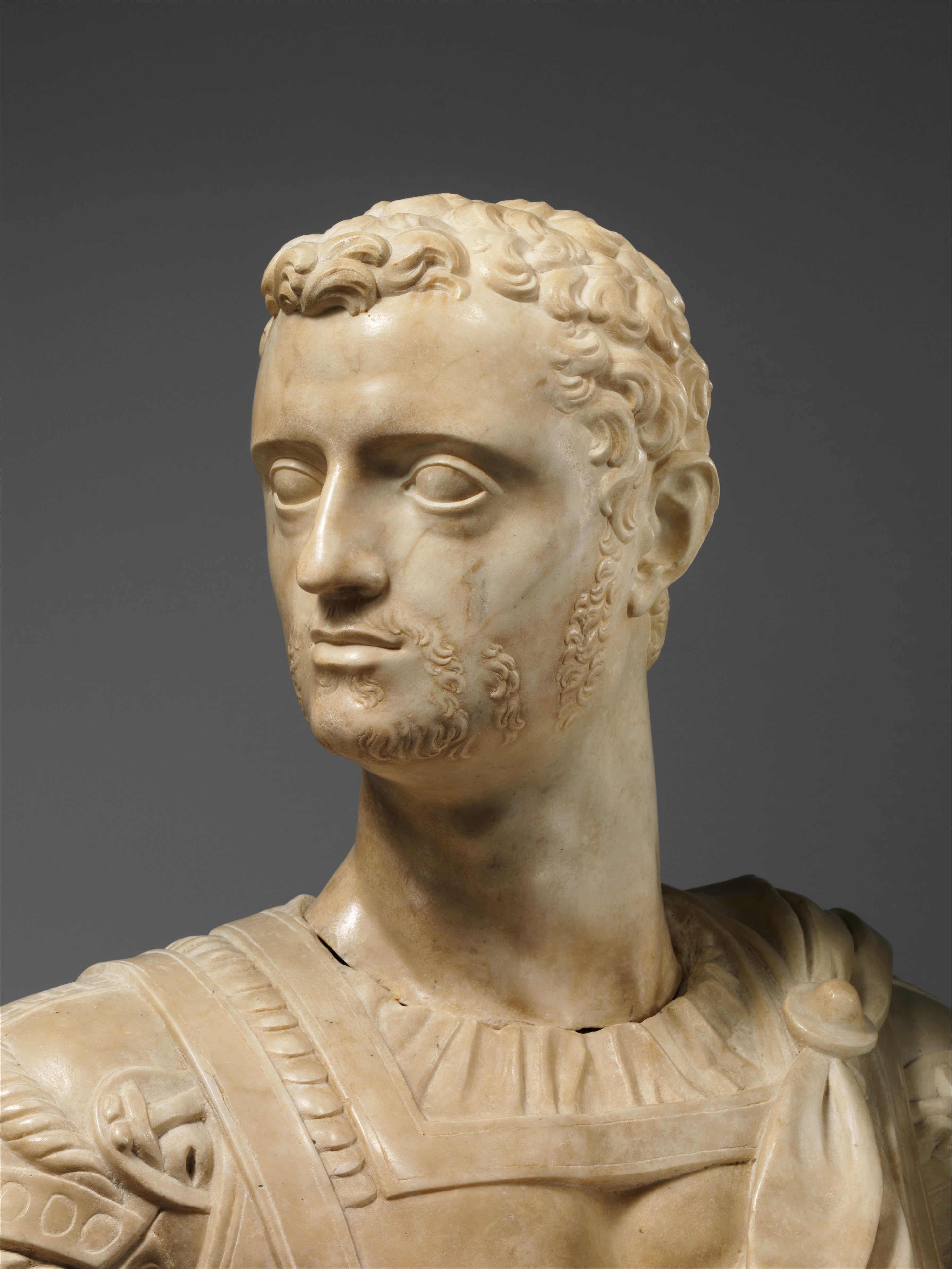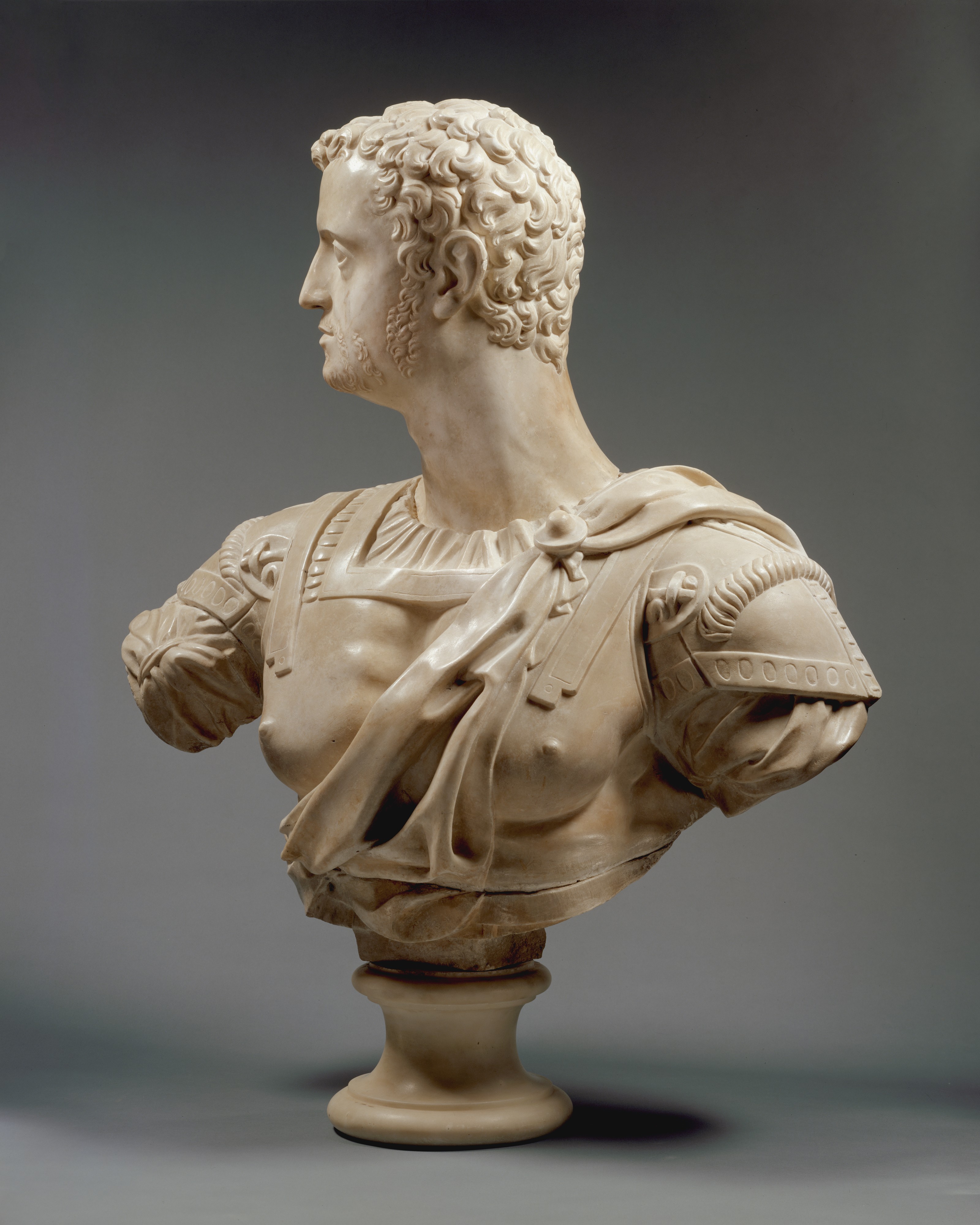Cosimo I de' Medici (1519–1574), Duke of Florence
Baccio Bandinelli Italian
In 1534, in rivalry with Michelangelo, Baccio Bandinelli carved the colossal Hercules and Cacus, a marble group that confronted the older sculptor’s famous David (finished in 1504) on the Piazza della Signoria in Florence. With their stiff postures and lapidary precision, the figures of Bandinelli’s group could not compete in grace and power with Michelangelo’s youth. Over the years, Bandinelli created a unique, even idiosyncratic, Mannerist style (the style prevalent in Italy after the 1520s) and achieved considerable success, yet constantly strove to emerge from Michelangelo’s shadow, and his competitive zeal intensified a tendency to exaggeration in his work. After the eighteen-year-old Cosimo de’ Medici became duke of Florence in 1537, the sculptor found increasing favor in his native city as well as in Rome. Through ducal patronage, he was supported in such major projects as the tombs of the Medici popes Leo X and Clement VII (1536 – 41, church of Santa Maria sopra Minerva, Rome) and works in the chancel of Florence Cathedral (1545 – 60).
His bust of Cosimo in the Metropolitan is one of the earliest sculptural portraits of the duke, probably the first done all’antica (in antique fashion). The young duke began to grow a beard in the first year of his reign, as medals by Domenico di Polo bear witness. Crisply defined in marble, the wispy strands of facial hair place the subject in the early years of adulthood.[1] A chalk drawing by the Florentine painter Pontormo, probably made in the year of Cosimo’s accession (Galleria degli Uffizi, Florence) displays the strong profile and confident demeanor seen in Bandinelli’s bust. The duke’s relative youth here is apparent when the Museum’s portrait is compared with Bandinelli’s better known bust of Cosimo from about 1543 – 44 (Museo Nazionale del Bargello, Florence), in which the subject’s face has fleshed out and his manner become even more assured. Nonetheless, the artist went to great lengths in the early bust to confer authority on his subject. The sharp turn of the head, a motif found in many of Bandinelli’s works, is meant to make Cosimo appear decisive; it appropriately echoes the pose of Michelangelo’s Giuliano de’ Medici, a famous seated, lifesize sculpture of a Medici youth of an earlier generation installed in 1534 in the Medici Chapel of the church of San Lorenzo, Florence. Duke Cosimo’s antique regalia — a laced cuirass and enveloping paludamentum, or robe of rank — have ancient imperial associations. From the beginning of his reign Cosimo was particularly eager to be compared with Augustus Caesar. He owned a bust of the youthful emperor (today untraced) as well as ancient cameos of Augustus, all of which reflect his cult of the Roman ruler.[2]
An unusual feature of the Museum’s bust, the separate carving of head and torso (which in turn is in three parts), is a known working method of Bandinelli, one that Giorgio Vasari noted in his Lives of the Artists, observing that it was frowned on by other sculptors: "It was the custom of Baccio [Bandinelli] to add pieces of marble both small and large to the statues that he executed, feeling no annoyance in doing this, and making light of it." [3] In fact, carving a bust in separate pieces was an ancient Roman practice, as Bandinelli would have known from examples he could study in Florence and Rome.[4] The odd truncation of his right arm might have necessitated — or at least been compatible with — the piecing of the marble.
Appropriately enough, Cosimo’s bust came early into the possession of staunch supporters of the Medici, the Niccolini family of Florence. It is likely that it is the first item in a list of five busts inventoried in the house of Cavaliere Lorenzo Niccolini on January 5, 1795, after his death.[5] More than two centuries earlier, the house was in the possession of Giovanni Niccolini, and it is possible that the bust was there at that time. [6] We know that in the eighteenth century the bust still stood on a tall, divided and tapered, walnut pedestal (sgabello) a type that had frequently been used for the display of sculpture during the mid-sixteenth century. The original iron ring cemented into the unfinished back suggests that the piece was once attached to a wall. The 1795 Niccolini inventory documents that the original socle was of the same stone as the bust; the present one is a later replacement.
[Ian Wardropper. European Sculpture, 1400–1900, In the Metropolitan Museum of Art. New York, 2011, no. 19, pp. 66–67.]
Footnotes:
1. Karla Langedijk. The Portraits of the Medici, Fifteenth–Eighteenth Centuries. 3 vols. Florence, 1981–87, vol. 1, pp. 495 – 500.
2. For the lost bust of Augustus, see Kurt W. Forster. "Metaphors of Rule: Political Ideology and History in the Portraits of Cosimo I de’ Medici." Mitteilungen des Kunsthistorischen Institutes in Florenz 15, no. 1 (1971), pp. 65-104, p. 88. For the cameos, see Wolf-Rudiger Megow. Kameen von Augustus bis Alexander Severus. Antike Münzen und geschnittene Steine 11. Deutsches Archäologisches Institut. Berlin, 1987, p. 166, a18, pl. 8, 6. The Metropolitan Museum collection contains a fine portrait cameo of Emperor Augustus dating between A.D. 41 and 54 (acc. no. 42.11.30).
3. "Ed aveva Baccio per costume, nelle statue ch’ e’ faceva, di mettere de’ pezzi piccoli e grandi di marmo, non gli dando noia il fare cio’, e ridendosene." Giorgio Vasari. Le vite de’ più eccellenti pittori, scultori ed archetettori. 2nd ed. 3 vols. Florence, 1568. 1906 ed., edited by Gaetano Milanesi. 9 vols. Florence, 1906, vol. 6, p. 174; English trans., Vasari 1568/1996, vol. 2, p. 293.
4. For one example, an Antonine-era bust in Ostia, see Raissa Calza, ed. Scavi di Ostia. Vol. 5, I ritratti. Pt. 1, Ritratti greci e romani fino al 160 circa d.C. Rome, 1964, pp. 108 – 9, no. 187.
5. A copy of the inventory (from the archives of the Niccolini family) is in the curatorial files of the Department of European Sculpture and Decorative Arts, Metropolitan Museum.
6. The sixteenth- and seventeenth-century biographies of Giovanni Bandini by Raffaello Borghini and Filippo Baldinucci give information about the house of Giovanni Niccolini. See Raffaello Borghini. Il Riposo. Florence, 1584, p. 638; Filippo Baldinucci. Notizie dei professori del disegno da Cimabue in qua. Florence, 1681-1728. Reprint ed., 7 vols. Florence, 1845-47. [Reprint ed., vols. 1-5. Florence, 1974-75.], vol. 3, p. 67
Due to rights restrictions, this image cannot be enlarged, viewed at full screen, or downloaded.
This artwork is meant to be viewed from right to left. Scroll left to view more.






